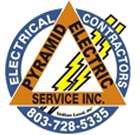Lighting contractors can help manage electrical faults
Lighting contractors in south Charlotte can help resolve electrical faults and make your property safe. Electrical faults are a common occurrence in both residential and commercial settings, often causing inconvenience and posing safety hazards. Understanding the types of faults that can occur is crucial for homeowners and electricians alike. Here, we’ll explore some of the most common electrical faults encountered and their potential causes.
1. Short Circuits:
Short circuits occur when a hot wire comes into contact with a neutral or ground wire, creating a low-resistance path for electrical current. This can result in excessive current flow, leading to overheating, sparks, and potentially fire. Common causes of short circuits include damaged insulation, loose connections, or faulty appliances.
2. Overloads:
Overloads happen when the electrical circuit is tasked with carrying more current than it can safely handle. This can occur when too many appliances are plugged into a single outlet or when high-wattage devices are used simultaneously. Overloads can cause circuit breakers to trip or fuses to blow, cutting off power to the affected circuit.
3. Ground Faults:
A ground fault occurs when an unintended connection between a hot wire and a ground surface or conductive material is established. This can happen due to damaged wiring or faulty appliances. Ground faults can pose significant safety risks, as they can result in electric shock or electrocution if left unaddressed.
4. Open Circuits:
Open circuits occur when there is a break in the electrical path, preventing current from flowing properly. This can happen due to loose connections, damaged wiring, or faulty switches. Open circuits can lead to malfunctioning electrical devices or fixtures, as they are unable to receive the necessary power to operate.
5. Voltage Sags and Surges:
Voltage sags (or dips) and surges are temporary fluctuations in voltage levels. Sags occur when the voltage drops below normal levels, while surges involve sudden increases in voltage. These fluctuations can damage sensitive electronic equipment and appliances. Common causes include lightning strikes, power grid issues, or large electrical loads switching on or off.
Diagnosing and Fixing Electrical Faults
Electricians employ various techniques and tools to diagnose and rectify electrical faults safely and efficiently. Below are the typical steps involved in diagnosing and fixing common electrical faults:
- Visual Inspection:
Electricians often begin by visually inspecting the affected area to look for obvious signs of damage, such as frayed wires, burn marks, or loose connections. This helps identify potential sources of the fault.
- Testing Equipment:
Electricians use specialized testing equipment such as multimeters, circuit testers, and voltage detectors to assess the electrical system’s health. These tools help measure voltage levels, test for continuity, and identify faulty components.
- Circuit Tracing:
For more complex faults, electricians may need to trace the circuit to pinpoint the exact location of the issue. This involves systematically checking connections, outlets, switches, and fixtures to identify any disruptions in the electrical flow.
- Repair or Replacement:
Once the fault is identified, electricians proceed to repair or replace the damaged components. This may involve tightening connections, replacing faulty wiring, or repairing/replacing damaged outlets, switches, or circuit breakers.
- Preventive Measures:
In addition to fixing the immediate fault, electricians may recommend preventive measures to reduce the likelihood of future issues. This could include upgrading outdated wiring, installing surge protectors, or redistributing electrical loads to prevent overloads.
- Testing and Verification:
After completing the repairs, electricians perform thorough testing to ensure that the electrical system is functioning correctly and safely. This may involve testing outlets, switches, and appliances to confirm proper operation and voltage levels.
- Safety Checks:
Finally, electricians conduct safety checks to verify that all electrical components meet code requirements and pose no safety hazards. This includes ensuring proper grounding, insulation, and compliance with local regulations.
- Educating the Homeowner:
As part of their service, electricians often take the time to educate homeowners about electrical safety practices and warning signs of potential faults. This empowers homeowners to recognize and address minor issues before they escalate into more significant problems.
- Regular Maintenance:
To prevent future electrical faults, electricians may recommend regular maintenance checks for the electrical system. This involves inspecting wiring, outlets, and switches for signs of wear or damage and addressing any issues proactively.
- Emergency Response:
In cases of severe electrical faults, such as fires or widespread power outages, electricians play a crucial role in emergency response efforts. They are trained to handle such situations safely and efficiently, restoring power and ensuring the safety of occupants.
- Advanced Diagnostics:
For complex or recurring electrical faults, electricians may employ advanced diagnostic techniques, such as thermal imaging or power quality analysis. These methods help identify underlying issues that may not be apparent through visual inspection alone.
Electricians play a vital role in diagnosing and fixing electrical faults and ensuring the safety, functionality, and efficiency of electrical systems in homes, businesses, and other settings. Through their expertise, professionalism, and commitment to customer service, electricians help safeguard lives and property while contributing to the well-being of their communities.
In conclusion, electrical faults are a common occurrence that can disrupt daily activities and pose safety risks. By understanding the types of faults that can occur and following proper diagnostic and repair procedures, electricians can effectively address these issues and ensure the safety and functionality of electrical systems. If you encounter electrical faults in your home or workplace, it’s essential to enlist the help of qualified electricians to diagnose and fix the problem promptly.
Top South Charlotte Residential Electrical Services Company
Pyramid Electric Services is an experienced professional electrical contracting company serving the Charlotte area, Marvin, Weddington, Mathews, Wesley Chapel, and Waxhaw. We are licensed and insured in North Carolina and South Carolina. When you want the best in residential electrical services and electrical installations, give us a call, at 803-728-5335.

